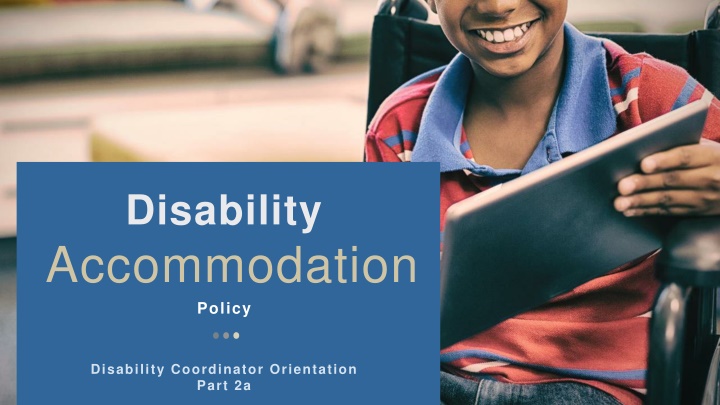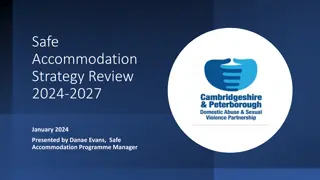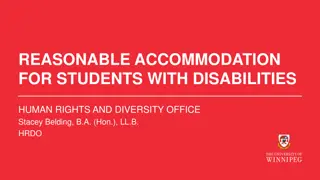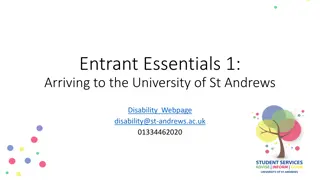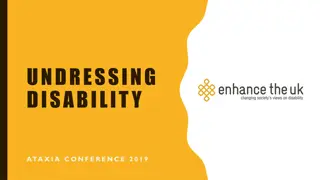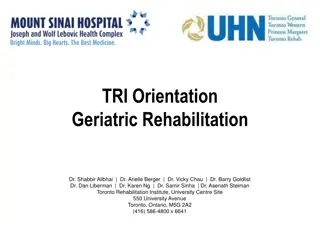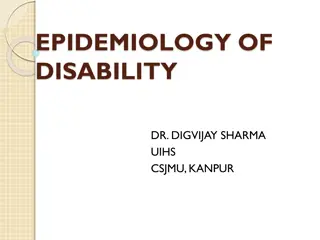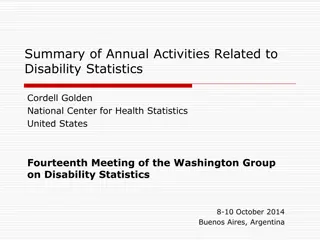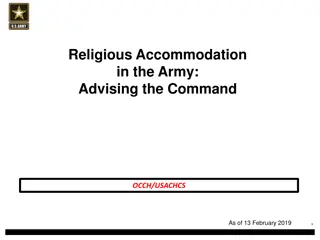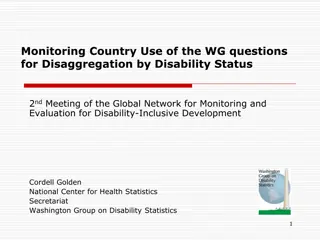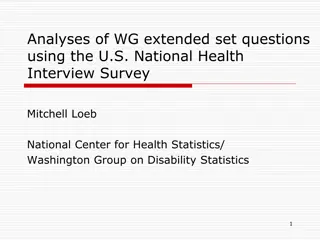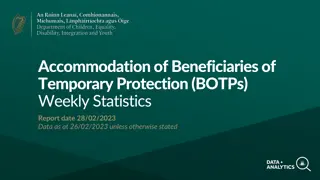Disability Accommodation
This content discusses the importance of effective communication in accommodating individuals with disabilities, outlining responsibilities, definitions, and key considerations. It emphasizes the separate obligations of communication and accommodation in ensuring equal access for all. The need for clear, accurate communication is highlighted to facilitate meaningful interactions in programs like Job Corps. The roles of the Disability Accommodation Committee (DAC) and the duty of Job Corps to provide necessary aids for effective communication are also explored.
Download Presentation

Please find below an Image/Link to download the presentation.
The content on the website is provided AS IS for your information and personal use only. It may not be sold, licensed, or shared on other websites without obtaining consent from the author.If you encounter any issues during the download, it is possible that the publisher has removed the file from their server.
You are allowed to download the files provided on this website for personal or commercial use, subject to the condition that they are used lawfully. All files are the property of their respective owners.
The content on the website is provided AS IS for your information and personal use only. It may not be sold, licensed, or shared on other websites without obtaining consent from the author.
E N D
Presentation Transcript
Disability Accommodation Policy Disability Coordinator Orientation Part 2a
Part 3: Part 1a - Applicant File Review - Policy Disability Coordinator Orientation Webinar Series Disability Data and Accommodation Plan Entry/ Notes Part 1b - Applicant File Review - Process Part 4: Part 1c - Maintaining and Managing AFR Tracking General Disability and Other Disability Program Requirements Part 2a - Disability Accommodation - Policy Part 2b - Disability Accommodation - Process The individual webinars can be attended in ANY order and routine attendance is strongly encouraged as content is updated on a regular basis. 2
Objectives Communication Documentation of Disability Definitions Describe the responsibilities and key considerations for communicating with an applicant with a disability. Explain what is a disability and what constitutes disability accommodations? List at least 3 appropriate sources of documentation of disability. DAC List the primary roles and responsibilities of the Disability Accommodation Committee (DAC). 3
Effective Communication Separate Obligation from RA and RM 4 4
C. A. B. Communication must be as effective as communication with others. Applies to all stages of the Job Corps process. The obligation to communicate effectively with people with disabilities is separate from the obligation to provide reasonable accommodation or reasonable modification in policies, practices, or procedures for qualified individuals with disabilities. Communicating with Individuals with Disabilities Appendix 201 5
Why is Effective Communication so Important? Without clear, accurate, effective communication, any encounter between a person with a disability and a program from which that person is seeking services, such as Job Corps, will be literally meaningless. 6
Who is Responsible to Ensure Effective Communication? Under the law, the burden is on Job Corps to provide the auxiliary aids and services (communication aids) that are needed for equally effective communication with a particular person with a disability. 7
Identifying or Determining What is Effective? Future Possibilities? First Determine HOW to communicate effectively with the individual with a disability. Primary consideration should be given to the requests of the person with a disability. https://blog.siggraph.org/2022/07/assistive-technology-enters-the-classroom- with-holographic-sign-language-interpreters.html/ Why do you think the law does this? 8
What are Communication-related Accommodations? Any adjustment or modification, support, and so forth that enables the individual to be able to both receive and express information that is meaningful to them. Examples might include such things as: Simplifying language to include rephrasing statements or questions and providing them in either oral or written formats as needed Securing interpreters or using hearing- assisted devices/text-to-speech technology Allowing written communication such as e- mails, texts, or other types of written responses Slowing the rate of speech and/or repeating phrases and giving extra time for processing Asking the recipient to repeat back information to confirm understanding Interviewing face-to-face instead of by phone Providing picture-related support/other symbols to convey meaning Providing more specialized accommodations as needed, such as a sign-language interpreter or video remote interpreting (VRI) 9
Disability Accommodations (DA) Policy Requirements PRH 2: 2.4, (R2) and 3.4, (R23); Appendices 201, Form 2-03, and Exhibit 5-1 10 10
DA Standard Operating Procedure (SOP) PRH 1: 1.5, Form 2-03, Exhibit 5-1 Requires DOL Regional Office approval! All centers are required to have a Disability Accommodation Process (DAP) SOP. DCs must ensure DA SOP is in place. Must include all components of the Disability Accommodation Process (DAP) in Form 2-03 DCs coordinate the center s DAP. 12
Defining Disability 13 13
Disability Definition Disability means, with respect to an individual: A physical or mental impairment that substantially limits one or more of the major life activities of such individual. 1414
Examples BRAND SUBTEXT Muscular dystrophy Multiple sclerosis Cancer Diabetes Psychological illness Drug addiction Alcoholism ADHD Orthopedic Visual/Hearing Speech Intellectual Learning disabilities HIV Cerebral palsy Epilepsy A physical or mental impairment 01 An impairment is a disability if it substantially limits the ability of an individual to perform a major life activity as compared compared to most people in the general population Requires an individualized assessment Should not require extensive analysis Should be construed broadly in favor of expansive coverage Defined that substantially limits 02 Disability Learning one or more of a person s major life activities Reading Concentrating An activity that is of central importance to daily life 03 Thinking Communicating Interacting with others Caring for oneself
Physical or mental impairment does not include Homosexuality and bisexuality 01 Transvestism, transsexualism, or gender identity disorders not resulting from physical impairments Disability 02 Pedophilia, exhibitionism, voyeurism, or other sexual behavior disorders; compulsive gambling, kleptomania, or pyromania 03 Not A Psychoactive substance-use disorders resulting from current illegal use of drugs 04
Deafness substantially limits hearing; Impairments that virtually always impose a substantial limitation Blindness substantially limits seeing; Intellectual disability substantially limits brain function; Partially or completely missing limbs or mobility impairments requiring the use of a wheelchair substantially limit musculoskeletal function; Autism substantially limits brain function; Cancer substantially limits normal cell growth; Cerebral palsy substantially limits brain function; Diabetes substantially limits endocrine function; Epilepsy, muscular dystrophy, and multiple sclerosis each substantially limits neurological function; Human Immunodeficiency Virus (HIV) infection substantially limits immune function; and Major depressive disorder, bipolar disorder, post-traumatic stress disorder, obsessive compulsive disorder, and schizophrenia each substantially limits brain function. 17
Mitigating Measures Mitigating measures include, but are not limited to: Medication, medical supplies, equipment, or appliances, low-vision devices, prosthetics including limbs and devices, hearing aid(s) and cochlear implant(s) or other implantable hearing devices, mobility devices, and oxygen therapy equipment and supplies Use of assistive technology Substantially limits a major life activity shall be made without regard to the ameliorative effects of mitigating measures Reasonable modifications in policies, practices, or procedures, and auxiliary aids and services Consider evidence of limitations the person experienced prior to using a mitigating measure Eyeglasses or contact lenses shall be considered Learned behavioral or adaptive neurological modifications Psychotherapy, behavioral therapy, or physical therapy
Episodic or Remission An impairment that is episodic or in remission is a disability if it would substantially limit a major life activity when it is active. This means that chronic impairments with symptoms or effects that are episodic rather than present all the time are disabilities even if the symptoms or effects substantially limit a major life activity only when the impairment is active. Epilepsy Hypertension Asthma Diabetes Major depressive disorder Bipolar disorder Schizophrenia Examples of impairments that may be episodic include:
Temporary Disability What are the considerations for someone to have a temporary disability? Concussions Broken limbs Surgery Back or Neck Injuries The effects of an impairment lasts or is expected to last less than 6 months Can be substantially limiting for purposes of establishing an actual disability or record of a disability
Drug Addiction Under the Americans with Disabilities Amendments Act (ADAAA) Protected: Not Protected: Addicted to drugs, no longer using drugs illegally and received/receiving treatment for drug addiction or who would have been otherwise rehabilitated Current illegal users of drugs Casually illegal user in the past, but did not become addicted 21
Alcoholism Under the ADAAA Persons who are alcoholics may be protected under the ADAAA as individuals with disabilities. Alcoholism is a physical or mental impairment. Individuals who are currently using alcohol are still protected under the ADAAA. Students with drug addiction or alcoholism disabilities are subject to the center s disciplinary policies and measures regarding the use and abuse of alcohol, as well as to Job Corps Zero Tolerance policy. 22
Disability Accommodations (DA) Reasonable Accommodation, Reasonable Modification in Policies, Practices and Procedures, and Auxiliary Aids and Services PRH 2: 2.4, (R2) and Form 2-03 23 23
Disability Accommodations There are 3 prongs to consider: Reasonable Accommodation Reasonable Modification in Policies, Practices, and Procedures Auxiliary Aids and Services 24 24
Examples of Reasonable Accommodation and Reasonable Modification Modified work or training schedules Modification of equipment or devices Adjustments or modifications to examinations, training materials or policies Provision of interpreters Use of assistive technology Use of behavioral related supports If your center has a policy against the use of headsets during the training day, can you allow a student with a noise related sensory functional limitation to use noise cancelling headsets? 25
More Examples of Changes to Policies/Procedures LEARNING DISABILITY ANXIETY DISORDER SEIZURE DISORDER Extended Time Breaks Bottom Bunk ADHD PHYSICAL DIABETES Elevator Pass Test in Private Setting Schedule Adjustment 26
Communication Access Realtime Translation (CART) The instant translation of the spoken word into English text using a stenotype machine, laptop and real-time software Auxiliary Aids and Services Form 2-03 and Appendix 201 Auxiliary Aids and Services are devices or services that enable effective communication. https://askjan.org/products/Communication-Access-Realtime-Translation-CART.cfm 27
Documentation of Disability Sources and Content 28 28
Documentation of Disability Resources Physicians Psychiatrists Psychologists Medical Specialists Therapists Social Workers Nurses Physical, speech, and occupational therapists 29
Documentation Types Examples IEPs 504 Plans School Medical Plans Vocational Rehabilitation Assessments Medical Records Chronic Care Management Plans Social Security Records 30
No Documentation Provided Factors to Consider What Disabilities are Obvious? If an applicant s or student s disability or need for RA/RM/AAS is not obvious, and they do not provide documentation to support a request for accommodation, then they may not be entitled to RA/RM/AAS. If an applicant/student suspects that they may have a disability that has not been diagnosed and is unable to pay for an evaluation, AS staff or a DC should provide the applicant/student with referral information. Examples include: Blindness Deafness Mobility Impairments 31
Documentation to Support Accommodations for Standardized Testing Use due diligence in granting testing accommodations! Testing accommodations should be provided only after documentation of the disability containing information that supports the need for the testing accommodations has been provided, unless the disability is obvious. Types of accommodations that are allowable in a standardized testing situation usually are more limited than in other environments because certain accommodations may significantly alter what the test is intended to measure. See also Appendix 301 and the TABE 11/12 Student Testing System Administrator s Guide. 32
Identifying Disability Accommodation DCsshould not spend a lot of time analyzing whether an applicant s/student s condition meets the definition of a disability or requesting extensive documentation. 33
Important! Disability Accommodation Requests Centers may not deny disability accommodations at the center level (i.e., determine that a request is unreasonable). For example, if an applicant or student requests a private room, the center cannot tell the student that Job Corps does not provide private rooms. First, the center may offer equally effective alternative accommodations (e.g., fewer roommates, room dividers, noise machines, etc.). If the individual does not accept the alternative accommodations, then the center must determine if providing the private room is reasonable or not. 34
Timelines Entering Disability Accommodations into CIS 35 35
Timelines for Entering Accommodation Plans Applicant Requests Student Requests TABE Accommodations Disclosure: Disclosure: Disclosure: Disclosure: Occurs during the admissions process. Occurs after enrollment/ arrival. Occurs during the admissions process. AP Entered: Occurs after first TABE. AP Entered: AP Entered: AP Entered: Enter prior to or on the day of the student s arrival. Enter as soon as possible after disclosure of disability. Enter prior to or on the day of the student s arrival. Enter as soon as possible after disclosure of disability. 36
Administrative Considerations Copy of Plan and AP Storage Protected Information/ Confidentiality Signing the AP A DC and student must sign the plan (soon after the student s arrival if the disclosure occurred during the admissions process or after the DAC meeting if the disclosure occurred after arrival). A copy of the plan must be provided to the student, and the original must be maintained in the student s AF. APs must not include information about an individual student s diagnosis, medication needs, or other health-related history. 37
Disability Accommodation Committee (DAC) Members and Responsibilities 38 38
Members of DAC Participants of the DAC varies depending on the nature of the request or disclosure. Academic Manager and/or the HWD as DCs Dedicated position for a DC CMHC Center Physician or equivalent TEAP Specialist Dentist Career Technical Manager Student s Counselor Rep of Center Depts. Affected by DA Request Community Agency or Partner Rep Advocate or Authorized Rep It Depends! Required! It Depends! 39
Disability Coordinator Role in Preparing for Arrival of a Student with a Disability Actions in Preparing for What is the Role of a Disability Coordinator (DC) in Preparing for Arrival of a Student with a Disability? Responsibilities in Preparation for Arrival Arrival of a Student with a Disability Once approval for enrollment has been confirmed by Wellness, then a DC (e.g., non-health DC, full-time DC, and/or the Health and Wellness Director DC) contacts the student with a disability to discuss the need for accommodations and develop an accommodation plan in preparation for arrival. Discuss requested accommodations (from applicant, Chronic Care Management Plans, or others on behalf of the applicant) Discuss other accommodation needs based upon identified functional limitations Cautions! ! Ensure RA/RM/AAS Request and DCC Form is completed. Only discuss requested accommodations and functional limitations related to conditions and/or documentation disclosed by the incoming student. Do not contact applicants to discuss accommodation needs BEFORE they have been approved for enrollment unless the accommodation considerations is a part of a Health Care Needs Assessment (HCNA) or a Direct Threat Assessment (DTA). Draft accommodation plan, if agreed upon, and enter Disability Accommodation Committee (DAC) notes into CIS Accommodation Plan notes. RA/RM/AAS Request and DCC Form: Reasonable Accommodation/ Reasonable Modification in Policies, Practices or Procedures, and Auxiliary Aids and Services Request and Disability Coordinator Contact Form
When Does DAP Occur? Requests RA/RM/AAS Provides documentation that they may be an individual with a disability who may need disability accommodation to participate in Job Corps Note: Accommodation requests may be made in any form (i.e., verbally, in writing, by other individuals, etc. but must be documented on the RA/RM/AAS Request DCC Form) Applicant/ Student Applicant/ Student Indicates on the Request Form or the 653, Health Questionnaire, that they would like to discuss the need for accommodations with the DC Applicant/ Student Applicant The disability is obvious 41
Primary Reasons DAC Must Meet Recommended Denial of Enrollment Applicant Appealed Denial of Enrollment Applicant or Student Requests DA to Participate in JC Program Applicant or Student Provides Documentation of Disability Concerns Identified During Effectiveness Review DC Receives Referral of Possible Need for AP Student Needs Assistance Securing HSE or Certification DA Student Enters Work-based Learning or Career Transition Readiness 42
Transfer/Readmit/Advanced Training Students with Existing APs Accommodation Files 43 43
Accommodation Files for Transfer/Readmit/Advanced Training Students with Existing APs If a student with an AP already in CIS transfers to another center, re- enrolls in the program, or is admitted to an advanced training program, the center must engage the individual in the DAP. 44
Previous Documentation Transfers, Readmission or Advanced Training If the documentation cannot be obtained, then document in the AP notes within CIS that the student previously had an AP documented in CIS and the center s efforts to obtain the documentation. Documentation Available? Documentation Not Received? Has or had the previous center uploaded documentation of the disability to E-Folder? Is there documentation of the disability in the Student Health Record (SHR)? If not, DC must request that the sending center upload the existing documentation. Then continue to provide the previously agreed upon accommodations. 45
Resources Websites 46 46
Job Corps Disability Support Services Website https://supportservices.jobcorps.gov/disability/Pages/default.aspx 47
Questions? 48
